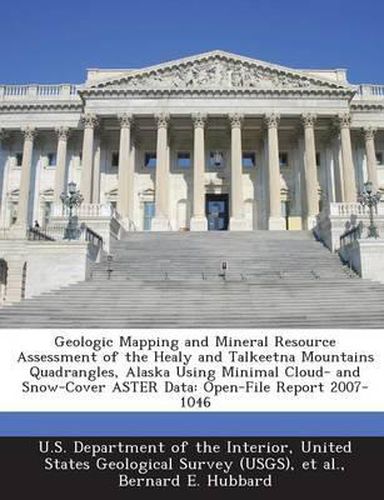Readings Newsletter
Become a Readings Member to make your shopping experience even easier.
Sign in or sign up for free!
You’re not far away from qualifying for FREE standard shipping within Australia
You’ve qualified for FREE standard shipping within Australia
The cart is loading…






On July 8, 2003, ASTER acquired satellite imagery of a 60 km-wide swath of parts of two 1:250,000 Alaska quadrangles, under favorable conditions of minimal cloud- and snow-cover. Rocks from eight different lithotectonic terranes are exposed within the swath of data, several of which define permissive tracts for various mineral deposit types such as: volcanic-hosted massive sulfides (VMS) and porphyry copper and molybdenum. Representative rock samples collected from 13 different lithologic units from the Bonnifield mining district within the Yukon-Tanana terrane (YTT), plus hydrothermally altered VMS material from the Red Mountain prospect, were analyzed to produce a spectral library spanning the VNIR-SWIR (0.4 - 2.5 ?m) through the TIR (8.1 - 11.7 ?m). Comparison of the five-band ASTER TIR emissivity and decorrelation stretch data to available geologic maps indicates that rocks from the YTT display the greatest range and diversity of silica composition of the mapped terranes, ranging from mafic rocks to silicic quartzites. The nine-band ASTER VNIR-SWIR reflectance data and spectral matched-filter processing were used to map several lithologic sequences characterized by distinct suites of minerals that exhibit diagnostic spectral features (e.g. chlorite, epidote, amphibole and other ferrous-iron bearing minerals); other sequences were distinguished by their weathering characteristics and associated hydroxyl- and ferric-iron minerals, such as illite, smectite, and hematite. Smectite, kaolinite, opaline silica, jarosite and/or other ferric iron minerals defined narrow (
$9.00 standard shipping within Australia
FREE standard shipping within Australia for orders over $100.00
Express & International shipping calculated at checkout
On July 8, 2003, ASTER acquired satellite imagery of a 60 km-wide swath of parts of two 1:250,000 Alaska quadrangles, under favorable conditions of minimal cloud- and snow-cover. Rocks from eight different lithotectonic terranes are exposed within the swath of data, several of which define permissive tracts for various mineral deposit types such as: volcanic-hosted massive sulfides (VMS) and porphyry copper and molybdenum. Representative rock samples collected from 13 different lithologic units from the Bonnifield mining district within the Yukon-Tanana terrane (YTT), plus hydrothermally altered VMS material from the Red Mountain prospect, were analyzed to produce a spectral library spanning the VNIR-SWIR (0.4 - 2.5 ?m) through the TIR (8.1 - 11.7 ?m). Comparison of the five-band ASTER TIR emissivity and decorrelation stretch data to available geologic maps indicates that rocks from the YTT display the greatest range and diversity of silica composition of the mapped terranes, ranging from mafic rocks to silicic quartzites. The nine-band ASTER VNIR-SWIR reflectance data and spectral matched-filter processing were used to map several lithologic sequences characterized by distinct suites of minerals that exhibit diagnostic spectral features (e.g. chlorite, epidote, amphibole and other ferrous-iron bearing minerals); other sequences were distinguished by their weathering characteristics and associated hydroxyl- and ferric-iron minerals, such as illite, smectite, and hematite. Smectite, kaolinite, opaline silica, jarosite and/or other ferric iron minerals defined narrow (